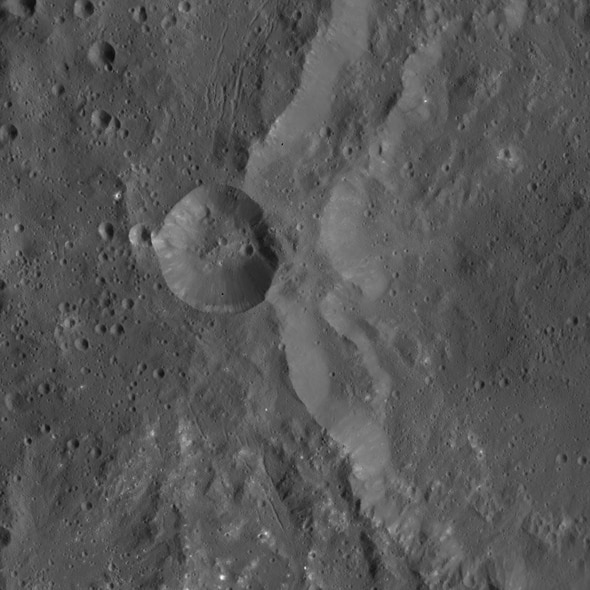Create a free profile to get unlimited access to exclusive videos, sweepstakes, and more!
White Spots Blemish the Face of Ceres

A new image of the protoplanet Ceres from the Dawn spacecraft caught my attention recently. It shows the western rim of a crater called Azacca (named after the Haitian god of agriculture; Ceres was the Roman goddess of agriculture). Only a portion of the 50-kilometer-wide crater is shown, but there’s a number of interesting features lurking there.
The most obvious is the small crater right on the rim. It’s younger than Azacca; it overlays the rim, so the impact that formed it must have happened after Azacca was already there. It’s fresher looking, with a sharp rim, though it has smaller craters inside, which implies it’s not exactly young. It’s been around long enough to collect some later impacts of its own.
The bright streaks along the young crater’s rim caught my eye. Once a crater is made, material along the walls can slide down into it, revealing material that was once under the surface. In this case, those brighter streaks are tantalizing. Are we seeing the same sort of bright material that has captured the imagination of so many people since Dawn first approached Ceres back in January of 2015?
The most likely culprit for these bright features is salt. Maybe magnesium sulfate, a common mineral. We know Ceres has a lot of water ice in it, which may have been a subsurface ocean, a mantle of water, early in its history. Salts would have dissolved in it, sticking around even today, long after the undersurface water froze. If so, some sort of process may still be bringing it to the surface to create the bright features we see now.
Look around that crater. See all the bright spots? Here’s a closer view:
Each pixel in the original (1,024 x 1,024) image is about 35 meters on the surface, and many of those spots are 2–10 pixels across, so 70 to 350 meters in width. At least some look like small impact craters. It’s likely there’s ice just under the surface, excavated when small asteroids impact Ceres.
Interestingly, I found an image of Azacca itself that also shows small white spots in it. I’d expect a large impact would vaporize the ice underneath the crater, yet there are those spots. Is ice from deeper within Ceres coming up through cracks/vents in the crust? There are much larger cracks in the floor of Azacca, possibly due to pressure underneath the crater pushing the floor up (though cracks in the surface have many different sources). Hmmmm.
As my friend Emily Lakdawalla wrote on her blog at the Planetary Society, the key to understanding the surface of Ceres is to understand what lies beneath. There are plenty of clues! With Dawn continuing to map this weird little world in high resolution, the evidence will continue to come in. I hope planetary scientists can make sense of the place. I do love a mystery, but I also love it when it’s solved. There are always more to take its place.


























